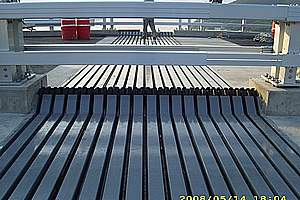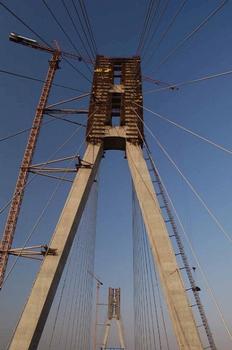General Information
| Completion: | 30 April 2005 |
|---|---|
| Status: | in use |
Project Type
| Structure: |
Cable-stayed bridge with semi-fan system |
|---|---|
| Function / usage: |
Motorway bridge / freeway bridge |
| Structure: |
Three-span cable-stayed bridge |
| Support conditions: |
for registered users |
| Secondary structure(s): |
Structurae Plus/Pro - Subscribe Now! |
| Material: |
Structurae Plus/Pro - Subscribe Now! |
| Secondary structure(s): |
Structurae Plus/Pro - Subscribe Now! |
Location
| Location: |
Zhenjiang, Jiangsu, China Yangzhou, Jiangsu, China |
|---|---|
| Part of: | |
| Coordinates: | 32° 13' 44.11" N 119° 21' 30.03" E |
Technical Information
Dimensions
| main span | 406 m |
Case Studies and Applied Products

TENSA®MODULAR LR & LR-LS – Modular expansion joints
Modular Expansion Joints can be constructed for any movements, from about 100 mm up to 2,000 mm and more. They allow movements in all 3 directions and rotations around all 3 axes.
[more]Excerpt from Wikipedia
The Runyang Yangtze River Bridge (simplified Chinese: 润扬长江大桥; traditional Chinese: 潤揚長江大橋; pinyin: Rùnyáng Chángjiāng Dàqiáo; Wu: Nye-yaan saon-gaon du-jiau) is a large bridge complex that crosses the Yangtze River in Jiangsu Province, China, downstream of Nanjing. The complex consists of two major bridges that link Zhenjiang on the south bank of the river and Yangzhou on the north. The bridge is part of the Yangzhou–Liyang Expressway. Construction of the bridge complex began in October 2000 and was completed ahead of schedule. The bridge cost 5.8 billion Yuan (about US$700 million). The complex opened to traffic on April 30, 2005. The total length of the bridge complex is about 35.66 kilometres (22.16 mi). In between the two bridges is the island of Shiyezhou.
Prior to the bridge's completion, round-the-clock ferry services operated across the river. It took about 40 minutes to reach the Zhenjiang Railway Station from Yangzhou. To this day, this nearby, round-the-clock ferry service operates across the river. The fee is approximately 15 yuan per small car, with a wait time of about 5 minutes. Cars and trucks drive directly onto the ferry boats before departure. Some locals estimate the ferries more quickly connect the city centers of Zhenjiang and Yangzhou.
South bridge
The south bridge is a suspension bridge with a main span of 1,490 metres (4,888 ft). Upon its completion in 2005 it became the third longest suspension bridge span in the world and the largest in China. With the opening of the Xihoumen Bridge in 2007, it became the second longest span in China. It is now the ninth longest in the world. The towers are 215 metres (705 ft) above water level. The two approach spans are not suspended. The main span of the bridge consists of a streamlined orthotropic steel box girder that is 3 metres (10 ft) in depth. The width of the deck is 39.2 metres (129 ft), accommodating 6 traffic lanes and a narrow walkway at each outside edge for maintenance. The height clearance for river navigation is about 50 metres (164 ft).
Another planned suspension bridge across the Qiongzhou Strait in China, will be larger than the south bridge, spanning between 2,000 and 2,500 metres.
North bridge
The north bridge is a cable-stayed bridge with a main span of 406 metres (1,332 ft) with towers 150 metres (492 ft) above water level.
Text imported from Wikipedia article "Runyang Yangtze River Bridge" and modified on May 27, 2022 according to the CC-BY-SA 4.0 International license.
Participants
Relevant Web Sites
Relevant Publications
- (2009): Balinghe oltre Millau. In: Strade e Autostrade, v. 13, n. 76 (July 2009), pp. 64-68.
- (2003): Chinese Engineers Dig in Deep To Build Runyang's Dynamic Duo. Crossings will form vital development link to rural area. In: Engineering News Record (24 November 2003).
- (2003): Double take: progress of China's Runyang Crossing over the Yangtze River. In: Bridge Design & Engineering, v. 9, n. 30 (1st Quarter 2003), pp. 38.
- (2008): Experimental and Analytical Studies on Static and Dynamic Characteristics of Steel Box Girder for Runyang Cable-Stayed Bridge. In: Advances in Structural Engineering, v. 11, n. 4 (August 2008), pp. 425-438.
- (2008): Finite Element Model Updating for the Runyang Cable-Stayed Bridge Tower Using Ambient Vibration Test Results. In: Advances in Structural Engineering, v. 11, n. 3 (June 2008), pp. 323-335.
- About this
data sheet - Structure-ID
20009228 - Published on:
05/05/2003 - Last updated on:
18/05/2022







